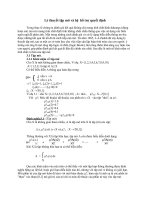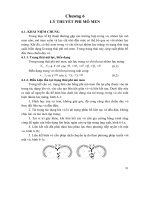Chương 4: Lý thuyết tập mờ & Logic mờ pdf
Bạn đang xem bản rút gọn của tài liệu. Xem và tải ngay bản đầy đủ của tài liệu tại đây (1.06 MB, 17 trang )
Chương 4: Lý thuyết tập mờ & Logic mờ
Trang 79
4.8. Bài tập chương 4
1. Cho Ω = {6, 2, 7, 4, 9}, các tập mờ A, B, C trên Ω tương ứng với ánh xạ µ
A
, µ
B
và
µ
C
như sau:
A = {(6,0.2), (2,0.9), (7,0.5), (4,0.3), (9,0.2)}
B = {(6,0), (2,1), (7,0.5), (4,0.6), (9,0.1)}
C = {(6,0.3), (2,0.1), (7,1), (4,0), (9,0.5)}
a/ Tính các tập A
C
, B
C
và C
C
với hàm thuộc về là 1-x
b/ Tính A∩B, B∩C, A∩B∩C, A∩C
C
, A∩C
C
với T(x,y) = min(x,y)
c/ Tính A∪B, B∪C, A∪B∪C, A∪C
C
, A∪C
C
với S(x,y) = max(x,y)
2. Cho các tập mờ A,B,C được định nghĩa trên nền số nguyên Ω = [0,5] với các hàm
thuộc về như sau: µ
A
=
2+x
x
và µ
B
=
x
1
Hãy xác định các tập mờ sau ở dạng liệt kê và đồ thị :
a/ Tính các tập A
C
, B
C
và C
C
với hàm thuộc về là 1-x
b/ Tính A∩B, B∩C, A∩B∩C, A∩C
C
, A∩C
C
với T(x,y) = min(x,y)
c/ Tính A∪B, B∪C, A∪B∪C, A∪C
C
, A∪C
C
với S(x,y) = max(x,y)
3. Thiết lập mô hình phân loại sinh viên qua các tập mờ sinh viên cần cù, sinh viên
thông minh và sinh viên lười.
4. Cho A là tập mờ xác định trên nền X. Hãy chỉ ra rằng biểu thức A∩C
C
= X không
đúng như đối với tập họp kinh điển.
5. Kiểm tra xem tập mờ A, B với các hàm thuộc về xác định ở bài tập 2 là thỏa hai
công thức của De Morgan.
Chương 4: Lý thuyết tập mờ & Logic mờ
Trang 80
CHƯƠNG 4 : LÝ THUYẾT TẬP MỜ & LOGIC MỜ 61
4.1. Tổng quan 61
4.2. Giới thiệu 61
4.3. Khái niệm tập mờ (fuzzy set) 62
4.4. Các phép toán về tập mờ 65
4.4.1. Phép bù 65
4.4.2. Phép giao 67
4.4.3. Phép hợp 69
4.4.4. Một số qui tắc 70
4.4.5. Phép kéo theo 71
4.5. Logic mờ 72
4.5.1. Định nghĩa mệnh đề mờ 72
4.5.2. Các phép toán trên logic mờ 73
4.6. Suy diễn mờ (Fuzzy inference) 73
4.7. Tổng kết chương 4 78
4.8. Bài tập chương 4 79
Predicates and Quantifiers: Suggested Exercises
1. Write each of the following expressions so that negations are only applied to propositional functions
(and not quantifiers or connectives).
(a)
(b)
(c)
(d)
(e)
2. Let =” likes ”, where the universe of discourse for and is the set of all people. For each
of the following, translate the expression to English, and tell the truth value.
(a)
(b)
(c)
(d)
(e)
(f)
(g)
3. Let =” ”, where the universe of discourse for all variables is the set of integers.
What are the truth values of each of the following?
(a)
(b)
(c)
(d)
(e)
(f)
(g)
(h)
(i)
4. Write each of the following sentences using quantifiers and propositional functions (if it is possible).
(a) All disc golfers play ultimate frisbee.
(b) If all students in my class do their homework, then some of the students will pass.
(c) If none of the students in my class study, then all of the students in my class will fail.
(d) Not everybody knows how to throw a frisbee 300 feet.
(e) Some people like ice cream, and some people like cake, but everybody needs to drink water.
(f) Everybody loves somebody.
(g) Everybody is loved by somebody.
(h) Not everybody is loved by everybody.
(i) Nobody is loved by everybody.
(j) You can’t please all of the people all of the time, but you can please some of the people some of
the time.
(k) If only somebody would give me some money, I would buy a new house.
(l) Nobody loves me, everybody hates me, I’m going to eat some worms.
(m) Every rose has it’s thorn, and every night has it’s dawn.
Rule Tautology
Rules of Inference
Disjunctive Syllogism
[
(p
∨
q)
∧¬
p]
→
q
Addition
p
→
(p
∨
q)
Simplification
(p
∧
q)
→
p
Contrapositive
(p
→
q)
→
(
¬
q
→¬
p)
Hypothetical Syllogism
[(p
→
q)
∧
(q
→r
)]
→
(p
→r
)
Modus Tollens
[
¬
q
∧
(p
→
q)]
→¬
p
Modus Ponens
[p∧(p→q)]→q
Conjunction
((p)
∧
(q))
→
(p
∧
q)
Rules of Inference for Quantifiers
Universal instantiation
∀x P(x)
∴ P(c) if c∈U
Universal generalization
P(c) for arbitrary c∈U
∴ ∀x P(x)
Existential instantiation
∃x P(x)
∴ P(c) for some c∈U
Existential generalization
P(c) for some c∈U
∴ ∃x P(x)
Equivalence Relations
Definition: A relation on a set is called an equivalence
relation if it is reflexive, symmetric, and transitive. Recall the
definitions:
reflexive: for all .
symmetric: when , for .
transitive: and implies ,
for
.
If two elements are related by an equivalence relation, they
are said to be equivalent.
1
Examples
1. Let be the relation on the set of English words such
that
if and only if starts with the same letter as .
Then
is an equivalence relation.
2. Let be the relation on the set of all human beings such
that
if and only if was born in the same country as
. Then is an equivalence relation.
3. Let be the relation on the set of all human beings such
that
if and only if owns the same color car as .
Then
is an not equivalence relation.
2
Congruence Modulo
Let be a positive integer. Then the relation
is an equivalence relation.
Proof: By definition,
if and only if
, for some integer . Using this,we proceed:
Since , we have that , and
is reflexive.
If , then , for some integer .
Thus,
, and we have , so
is symmetric.
3
If , and , then we have
and , for integers and . Thus,
and we have , and is transitive.
Therefore, congruence modulo is an equivalence relation
4
Definition: Let be an equivalence relation on a set . The
equivalence class of
is
In words, is the set of all elements that are related to the
element
. If the relation is clear, we can omit the
subscript (i.e.
instead of ).
If
, then is called a representative of the equivalence
class.
5
Examples Continued
1. The equivalence class of Xenon is all words starting with
the letter X. That is,
Xenon is an English word starting with the letter X
2. The equivalence class of Chuck Cusack is all people born
in the United States of America. That is,
Chuck Cusack is a person that was born in the U.S.A.
6
Example: Congruence Classes Modulo
The congruence class of an integer modulo is denoted by
.
Thus,
7
Equivalence Classes and Partitions
Theorem 1: Let be an equivalence relation on a set . The
following statements are equivalent:
Proof: Show that , , and .
Notice that this theorem says that if the intersection of two
equivalence classes is not empty, then they are equal. That is,
two equivalence classes are either equal or disjoint.
8
Definition: A partition of a set is a collection of disjoint
nonempty subsets of
whose union is . That is, a partition
of
is a collections of subsets , such that
for ,
when and
( is an index set. For example, often .)
9
Theorem 2: Let be an equivalence relation on a set .
Then the equivalence classes of
form a partition of .
Conversely, given a partition
of the set , there
is an equivalence relation
that has the sets , , as its
equivalence classes.
Proof (informal): The equivalence classes of an equivalence
relation are nonempty (since
), and by Theorem 1 are
disjoint. Since every element of the set
is in some
equivalence class (e.g.
), the equivalence classes
partition
.
10
(Proof of Theorem 2, continued)
Now, assume we have a partition of a set .
Define a relation on by if and only if for
some . It is not hard to see that this is an equivalence relation
Example: We can partition the set of integers according to
the equivalence classes modulo
as follows:
11
Example: Let be the equivalence relation on the set of
English words defined by
if and only if starts with the
same letter as
. Then we can partition the set of English
words as follows:
12
Logical Equivalences
Name Equivalence
p
∧
q
⇔
q
∧
p
Commutative laws
p
∨
q
⇔
q
∨
p
p
∧F ⇔ F
Domination laws
p
∨T ⇔ T
p
∨F ⇔
p
Identity laws
p
∧T ⇔
p
p
∧
p
⇔
p
Idempotent laws
p
∨
p
⇔
p
Double negation law
¬
(
¬
p)
⇔
p
(Unofficial name)
p
∧¬
p
⇔ F
Cancellation laws
p
∨¬
p
⇔ T
(p
∧
q)
∧r ⇔
p
∧
(q
∧r
)
Associative laws
(p
∨
q)
∨r ⇔
p
∨
(q
∨r
)
p
∧
(q
∨r
)
⇔
(p
∧
q)
∨
(p
∧
r
)
Distributive laws
p
∨
(q
∧r
)
⇔
(p
∨
q)
∧
(p
∨r
)
¬
(p
∨
q)
⇔ ¬
p
∧¬
q
De Morgan’s laws
¬
(p
∧
q)
⇔ ¬
p
∨¬
q
Implication law
(p
→
q)
⇔
(
¬
p
∨
q)









